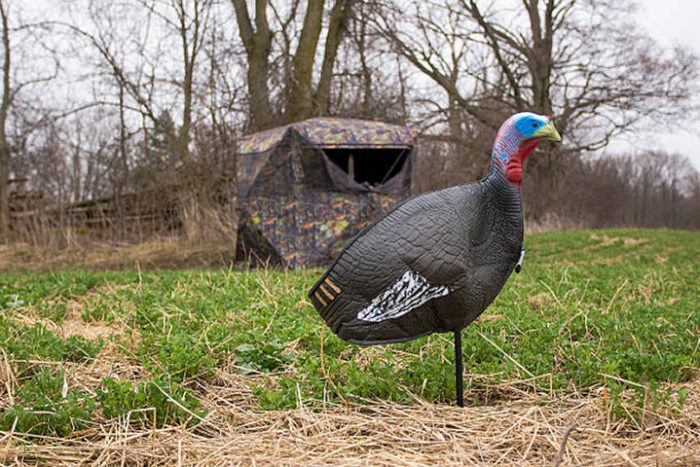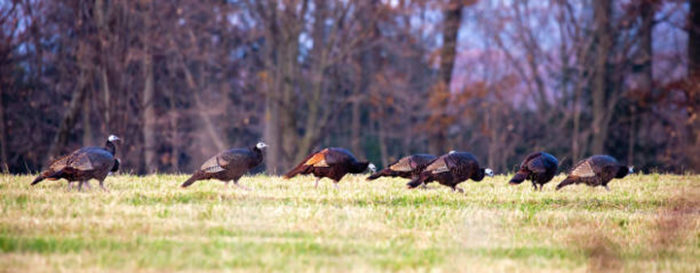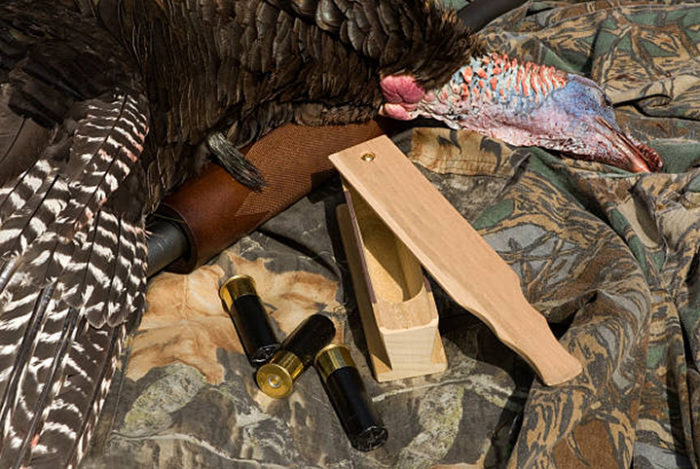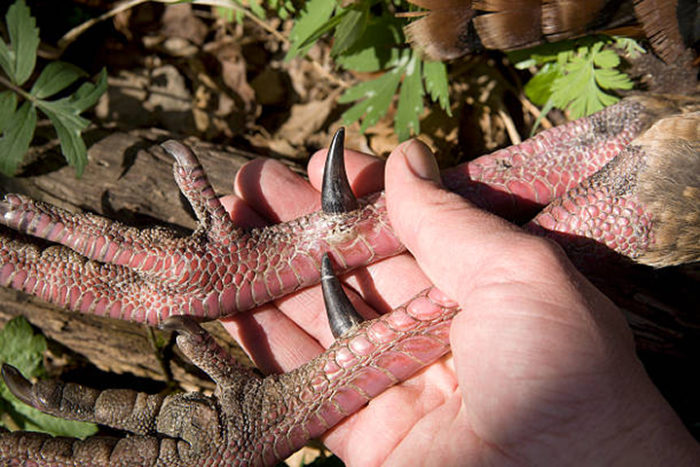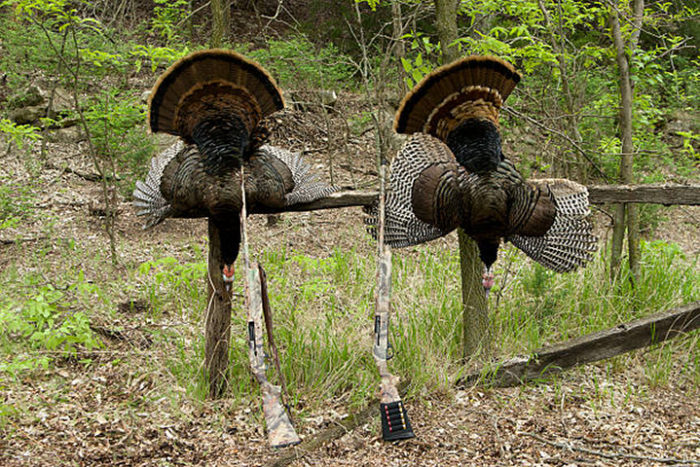Fall Flocks: Tried and True Turkey Hunting Tactics
One of wildlife conservation’s most celebrated stories is the comeback of the wild turkey. There was a time when it was rare to sight a wild turkey roaming around, but, thanks to bird releases and habitat management, today the United States is home to more than seven million birds.
Throughout the fall, turkeys play by a different set of rules than they do during the spring hunt. Strategies that worked in the early part of the year just won’t bring home those hens and fall gobblers. If your plans for the holidays involve a wild turkey dinner, putting out a platter of home-caught bird requires some changes to your current playbook.
1. Search out the flock
Your chances of bringing home the turkey increase when you have scoped out where the flocks hang out. There are three types of turkey flocks and, by the middle of October, most gobblers have joined one based on their gender and age. Poults and hens make up the largest group. The bachelor group is home to the toms. Ready for adventure, the jakes split into gangs of explorers.
When you are near grain fields, the flocks are simple to find. However, since they forage over a range of several hundred acres, it may be some time before they return to the same spot. Concentrate your search on the scrub they scour for berries and seeds, the ridges they cruise for acorns, and the field edges and grass lanes they meander while on the hunt for grasshoppers.
If you are having difficulty locating any obvious potential flock spots, start searching the ground. The carpet really gets ripped up by a flock, and scratchings are visible even several hours later. As you begin your search, take care to listen carefully and walk slowly, peeking around corners and over ridges to spot your prey before they spot you.
2. Engage in some tom talking
While toms follow hen chatter during the spring, when fall rolls around, they are no longer in chase mode and tend to ignore the talk from hens. In the fall their focus is climbing rungs on the social ladder. To use calls effectively, utilize clucks and yelps to garner the interest of fall toms. This puts out a call like that of a newcomer trying to fit in and piques their curiosity.
Although they will come in quietly to see what all the fuss is about, you may find you receive an answer to your call. When this occurs, often it is one of the flock’s dominant toms.
Another way to invite both jakes and toms to reveal their position is by staging your version of a mock fight. Leaf thrashing, beating wings, and provoked purrs tend to draw in the curious—especially the jakes, who love to bear witness to a good fight.
3. The early hunter gets the bird
To find out if the bushes you plan to hunt contain turkeys, it is best to set up before the sun makes its first appearance. While the turkeys are still sleeping, find a good hunting spot up high that allows for excellent distance hearing. As the flock comes off the roost, its members make plenty of noise yelping to determine the position of the others. When they fly down, they tend to cackle until they are on the ground, where they are extremely social, clucking while they mill around with one another.
Before heading off in search of breakfast, the dominant hen may give an assertive yelp, calling all the poults and hens to her side. If you are relying on your ears only, a flock of toms will beat their wings heavier and slower than the females. There may also be some dominance-asserting gobbles in case, overnight, the remainder of the flock forgot who is still in charge. Knowing what type of flock you have discovered is vital to ensure you are calling to the proper gender.
4. Hen hounding done right produces results
When the flock you are after is made up of poults and hens, draw them to your location with hen purrs and clucks, but don’t expect to hear much calling back from the birds. When you are calling blindly, use the assembly yelp of the boss hen. This one takes some practice, but the younger members of the flock will respond to the long series of yelps—use a minimum of 20 yelps.
If you are lucky, the older flock members will also head over to where you are set up when you use the assembly yelp. When all you get are birds you consider to be too small to take, try using the kee-kee run, or lost poult call, to get curious to investigate.
5. Flock flushing could do the trick
You have found a flock, but there is no way you can call them toward your position before legal light. What do you do? The goal is to get the flock to scatter as far apart as possible, and this is accomplished by running directly into the flock like a maniac. Bark like a dog, scream like crazy—do whatever you must to get them moving in every direction.
Now you will have plenty of time to get set up properly since it will take a minimum of 30 minutes for the birds to calm down and begin to regroup. The sweet spot you want is somewhere near whatever direction the majority ran. Once they have started to call out to each other, begin making calls of your own to lure them into range. Keep in mind, this doesn’t work with the crafty toms since they are much slower to regroup than flocks of jakes or poults and hens.
6. Hunt turkeys in your hand and elk in your mind
Elk and turkey share plenty of the same habitat areas, so, if there are elk near where you wish to hunt, there is a good chance wild turkeys inhabit the area. There is also an overlap between the two species in defensive and breeding behaviors, meaning hunters with elk-in-rut experience are far ahead of the game.
A tag team of two hunters is highly effective if the shooter is positioned between the target and the caller. Since the bird focuses on where the sound is originating—just like elk—there is an increased chance of a perfect shot opportunity that is relaxed and up nice and close.
Final Thoughts
With increased numbers of hunters out in the woods, fall turkey hunts are inherently more dangerous. However, they also have the potential for higher thrill and intensity factors. Have you ever witnessed an angry tom with his neck poker straight, running to fight? Do you have stories of being stampeded by jake gangs in full brawl mode? Or, perhaps you have been the victim of a swarming when the boss hen vocalized her displeasure and sent the flock to “attack.”
Whatever tactics you use to bag your Thanksgiving turkey, always put your safety and the safety of others first.
Ross Burgess serves as the Marketing Director for eKnives. When he’s not creating content, he spends his free time camping, hiking, hunting, and teaching his grand-daughter how to do so, too. He’s always had a passion for the outdoors, and now he gets to teach others about it through the digital world.”

